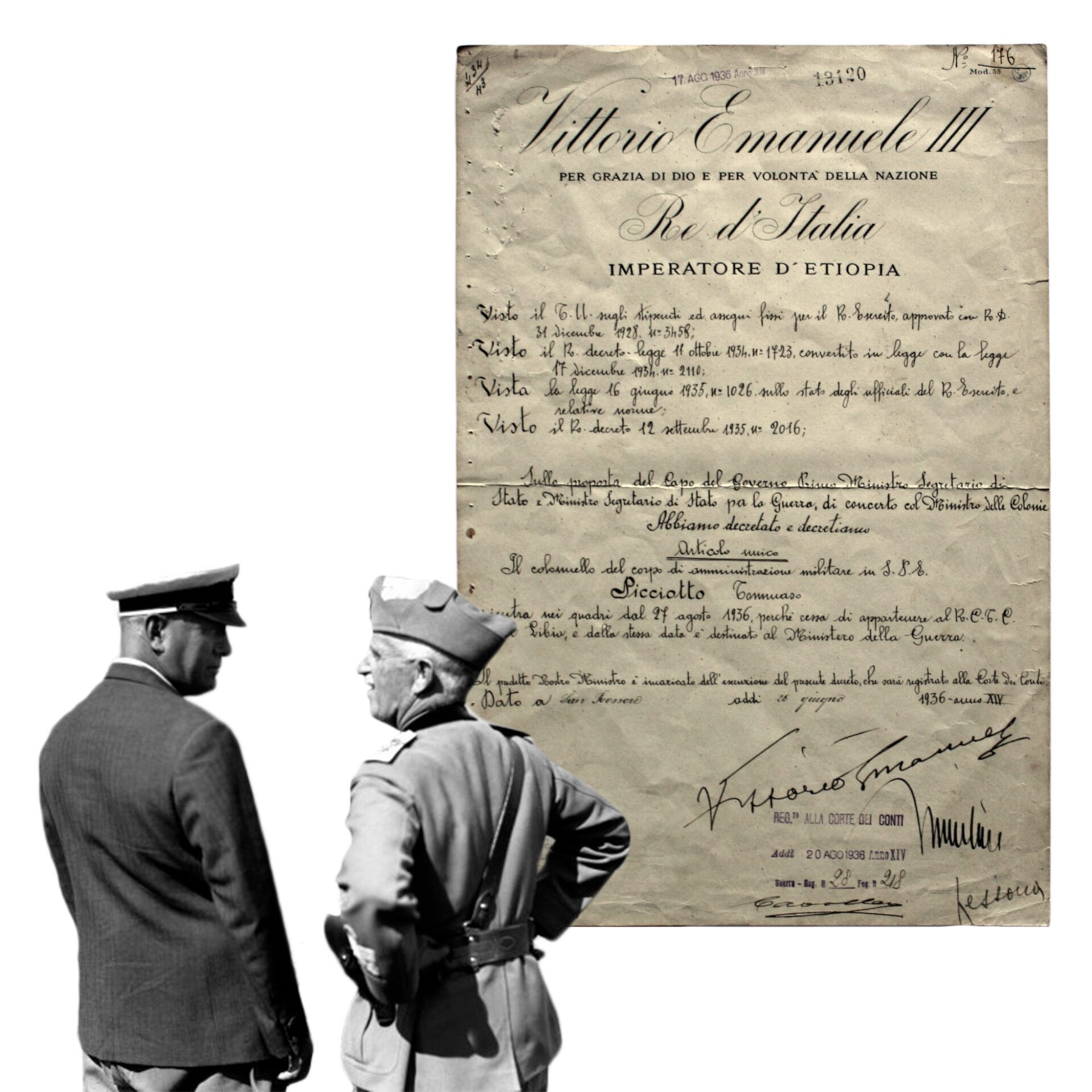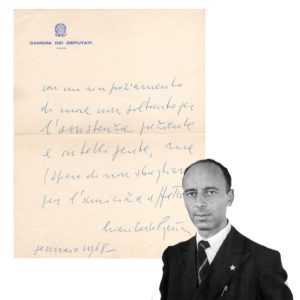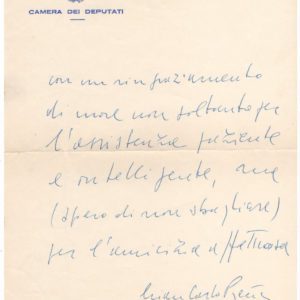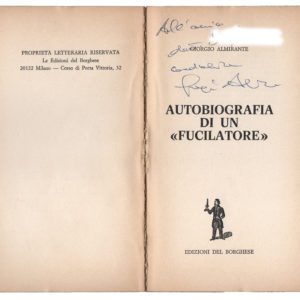Description
BENITO MUSSOLINI BIOGRAPHY :
Benito Amilcare Andrea Mussolini (I29 July 1883 – 28 April 1945) was an Italian politician and journalist who founded and led the National Fascist Party. He was Prime Minister of Italy from the March on Rome in 1922 until his deposition in 1943, and “Duce” of Italian Fascism from the establishment of the Italian Fasces of Combat in 1919 until his execution in 1945 by Italian partisans. As dictator of Italy and principal founder of fascism, Mussolini inspired and supported the international spread of fascist movements during the inter-war period. Mussolini was originally a socialist politician and a journalist at the Avanti! newspaper. In 1912, he became a member of the National Directorate of the Italian Socialist Party (PSI), but he was expelled from the PSI for advocating military intervention in World War I, in opposition to the party’s stance on neutrality. In 1914, Mussolini founded a new journal, Il Popolo d’Italia, and served in the Royal Italian Army during the war until he was wounded and discharged in 1917. Mussolini denounced the PSI, his views now centering on Italian nationalism instead of socialism, and later founded the fascist movement which came to oppose egalitarianism and class conflict, instead advocating “revolutionary nationalism” transcending class lines. On 31 October 1922, following the March on Rome (28–30 October), Mussolini was appointed prime minister by King Victor Emmanuel III, becoming the youngest individual to hold the office up to that time. After removing all political opposition through his secret police and outlawing labor strikes, Mussolini and his followers consolidated power through a series of laws that transformed the nation into a one-party dictatorship. Within five years, Mussolini had established dictatorial authority by both legal and illegal means and aspired to create a totalitarian state. In 1929, Mussolini signed the Lateran Treaty with the Holy See to establish Vatican City. Mussolini’s foreign policy aimed to restore the ancient grandeur of the Roman Empire by expanding Italian colonial possessions and the fascist sphere of influence. In the 1920s, he ordered the Pacification of Libya, instructed the bombing of Corfu over an incident with Greece, established a protectorate over Albania, and incorporated the city of Fiume into the Italian state via agreements with Yugoslavia. In 1936, Ethiopia was conquered following the Second Italo–Ethiopian War and merged into Italian East Africa (AOI) with Eritrea and Somalia. In 1939, Italian forces annexed Albania. Between 1936 and 1939, Mussolini ordered the successful Italian military intervention in Spain in favor of Francisco Franco during the Spanish civil war. Mussolini’s Italy initially tried to avoid the outbreak of a second global war, sending troops at the Brenner Pass to delay Anschluss and taking part in the Stresa front, the Lytton Report, the Treaty of Lausanne, the Four-Power Pact and the Munich Agreement. However, Italy then alienated itself from Britain and France by aligning with Germany and Japan. Germany invaded Poland on 1 September 1939, resulting in declarations of war by France and the UK and the start of World War II. On 10 June 1940, Mussolini decided to enter the war on the Axis side. Despite initial success, the subsequent Axis collapse on multiple fronts and eventual Allied invasion of Sicily made Mussolini lose the support of the population and members of the Fascist Party. As a consequence, early on 25 July 1943, the Grand Council of Fascism passed a motion of no confidence in Mussolini; later that day King Victor Emmanuel III dismissed him as head of government and had him placed in custody, appointing Pietro Badoglio to succeed him as Prime Minister. After the king agreed to an armistice with the Allies, on 12 September 1943 Mussolini was rescued from captivity in the Gran Sasso raid by German paratroopers and Waffen-SS commandos led by Major Otto-Harald Mors. Hitler, after meeting with the rescued former dictator, then put Mussolini in charge of a puppet regime in northern Italy, the Italian Social Republic (Italian: Repubblica Sociale Italiana, RSI), informally known as the Salò Republic, causing a civil war. In late April 1945, in the wake of near total defeat, Mussolini and his mistress Clara Petacci attempted to flee to Switzerland, but both were captured by Italian communist partisans and summarily executed by firing squad on 28 April 1945 near Lake Como. The bodies of Mussolini and his mistress were then taken to Milan, where they were hung upside down at a service station to publicly confirm their demise.
VITTORIO EMANUELE III BIOGRAPHY :
Victor Emmanuel III (Vittorio Emanuele Ferdinando Maria Gennaro di Savoia; Italian: Vittorio Emanuele III, Albanian: Viktor Emanueli III; 11 November 1869 – 28 December 1947) reigned as King of Italy from 29 July 1900 until his abdication on 9 May 1946. He also reigned as Emperor of Ethiopia (1936–1941) and King of the Albanians (1939–1943). During his reign of nearly 46 years, which began after the assassination of his father Umberto I, the Kingdom of Italy became involved in two world wars. His reign also encompassed the birth, rise, and fall of Italian Fascism and its regime. During the First World War, Victor Emmanuel III accepted the resignation of Prime Minister Paolo Boselli and named Vittorio Emanuele Orlando (the premier of victory) in his place. Following the March on Rome, he appointed Benito Mussolini as Prime Minister, later deposing him in 1943 during the Allied invasion of Italy during the Second World War. Victor Emmanuel abdicated his throne in 1946 in favour of his son Umberto II, hoping to strengthen support for the monarchy against an ultimately successful referendum to abolish it. He then went into exile to Alexandria, Egypt, where he died and was buried the following year in St. Catherine’s Cathedral of Alexandria. In 2017, his remains were returned to rest in Italy, following an agreement between Italian President Sergio Mattarella and Egyptian President Abdel Fattah el-Sisi. Victor Emmanuel was also called by some Italians Sciaboletta (“little saber”), due to his height of 1.53 m (5 ft 0 in), and il Re soldato (the Soldier King), for having led his country during both world wars.










